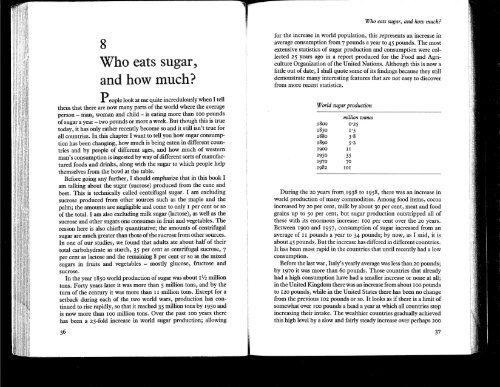John_Yudkin_-_Pure_White_and_Deadly_revised_1986_OCR
John_Yudkin_-_Pure_White_and_Deadly_revised_1986_OCR
John_Yudkin_-_Pure_White_and_Deadly_revised_1986_OCR
Create successful ePaper yourself
Turn your PDF publications into a flip-book with our unique Google optimized e-Paper software.
Who eats sugar, <strong>and</strong> how much?<br />
8<br />
Who eats sugar,<br />
<strong>and</strong> how much?<br />
People look at me quite incredulously when I tell<br />
them that there are now many parts of the world where the average<br />
person - man, woman <strong>and</strong> child - is eating more than 100 pounds<br />
of sugar a year - two pounds or more a week. But though this is true<br />
today, it has only rather recently become so <strong>and</strong> it still isn't true for<br />
all countries. In this chapter I want to tell you how sugar consumption<br />
has been changing, how much is being eaten in different coun,<br />
tries <strong>and</strong> by people of different ages, <strong>and</strong> how much of western<br />
man's consumption is ingested by way of different sorts of manufactured<br />
foods <strong>and</strong> drinks, along with the sugar to which people help<br />
themselves from the bowl at the table.<br />
Before going any further, I should emphasize that in this book I<br />
am talking about the sugar (sucrose) produced from the cane <strong>and</strong><br />
beet. This is technically called centrifugal sugar. I am excluding<br />
sucrose produced from other sources such as the maple <strong>and</strong> the<br />
palm; the amounts are negligible <strong>and</strong> come to only I per cent or so<br />
of the total. I am also excluding milk sugar (lactose), as well as the<br />
sucrose <strong>and</strong> other sugars one consumes in fruit <strong>and</strong> vegetables. The<br />
reason here is also chiefly quantitative; the amounts of centrifugal<br />
sugar are much greater than those of the sucrose from other sources.<br />
In one of our studies, we found that adults ate about half of their<br />
total carbohydrate as starch, 35 per cent as centrifugal sucrose, 7<br />
per cent as lactose <strong>and</strong> the remaIDing 8 per cent or so as the mixed<br />
sugars in fruits <strong>and</strong> vegetables - mostly glucose, fructose <strong>and</strong><br />
sucrose.<br />
In the year 1850 world production of sugar was about 1 liz million<br />
tons. Forty years later it was more than 5 million tons, <strong>and</strong> by the<br />
turn of the century it was more than I I million tons. Except for a<br />
setback during each of the two world wars, production has continued<br />
to rise rapidly, so that it reached 35 million tons by 1950 <strong>and</strong><br />
is now more than 100 million tons. Over the past 100 years there<br />
has been a 25-fold increase in world sugar production; allowing<br />
36<br />
for the increase in world population, this represents an increase in<br />
average consumption from 7 pounds a year to 45 pounds. The most<br />
extensive statistics of sugar production <strong>and</strong> consumption were collected<br />
25 years ago in a report produced for the Food <strong>and</strong> Agriculture<br />
Organization ofthe United Nations. Although this is now a<br />
little out of date, I shall quote some of its findings because they still<br />
demonstrate many interesting features that are not easy to discover<br />
from more recent statistics.<br />
World sugar production<br />
million tonnes<br />
1800 0·25<br />
1850 1·5<br />
1880 3·8<br />
181}O 5.2<br />
ll}OO II<br />
1950 35<br />
1970 70<br />
1982 101<br />
During the 20 years from 1938 to 1958, there was an increase in<br />
world production of many commodities. Among food items, cocoa<br />
increased by 20 per cent, milk by about 30 per cent, meat <strong>and</strong> food<br />
grains up to 50 per cent, but sugar production outstripped all of<br />
these with its enormous increase: 100 per cent over the 20 years.<br />
Between 1900 <strong>and</strong> 1957, consumption of sugar increased from an<br />
average of I I pounds a year to 34 pounds; by now, as I said, it is<br />
about 45 pounds. But the increase has differed in different countries.<br />
It has been most rapid in the countries that until recently had a low<br />
consumption.<br />
Before the last war, Italy's yearly average was less than 20 pounds;<br />
by 1970 it was more than 60 pounds. Those countries that already<br />
had a high consumption have had a smaller increase or none at all;<br />
in the United Kingdom there was an increase from about 100 pounds<br />
to 120 pounds, while in the United States there has been no change<br />
from the previous 102 pounds or so. It looks as if there is a limit of<br />
somewhat over 100 pounds a head a year at which all countries stop<br />
increasing their intake. The wealthier countries gradually achieved<br />
this high level by a slow <strong>and</strong> fairly steady increase over perhaps 200<br />
37



